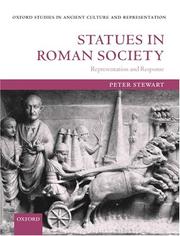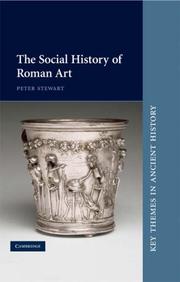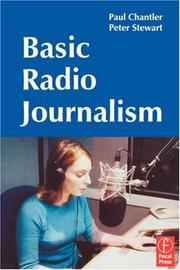| Listing 1 - 10 of 13 | << page >> |
Sort by
|

ISBN: 0199240949 Year: 2003 Volume: *1 Publisher: Oxford Oxford university press
Abstract | Keywords | Export | Availability | Bookmark
 Loading...
Loading...Choose an application
- Reference Manager
- EndNote
- RefWorks (Direct export to RefWorks)
Statues were everywhere in the Roman world. They served as objects of cult, honors to emperors and noblemen, and memorials to the dead. Combining close attention to individual Roman texts and images with an unprecedented broad perspective on this remarkable phenomenon, Statues in Roman Society explains the impact that all kinds of statuary had on the ancient population.
Portrait sculpture [Roman ] --- Portraits sculptes romains --- Portretsculptuur [Romeinse ] --- Art and society --- Portrait sculpture, Roman. --- Statues --- Symbolism in art --- Portrait sculpture, Roman --- Allegory (Art) --- Signs and symbols in art --- Art --- Statuary --- Monuments --- Sculpture --- Roman portrait sculpture --- Art and sociology --- Society and art --- Sociology and art --- Social aspects --- Rome

ISBN: 9780521816328 0521816327 9780521016599 0521016592 Year: 2008 Volume: *17 Publisher: Cambridge : Cambridge university press,
Abstract | Keywords | Export | Availability | Bookmark
 Loading...
Loading...Choose an application
- Reference Manager
- EndNote
- RefWorks (Direct export to RefWorks)
The character of Roman art history has changed in recent years. More than ever before, it is concerned with the role of art in ancient society, including the functions that it served and the values and assumptions that it reflects. At the same time, images have become centrally important to the study of ancient history in general. This book offers a new, critical introduction to Roman art against the background of these developments. Focusing on selected examples and themes, it sets the images in context, explains how they have been interpreted, and explodes some of the modern myths that surround them. It also explores some of the problems and contradictions that we face when we try to deal with ancient art in this manner. From wall-paintings to statues, from coins to the gravestones, this is a lucid and often provocative reappraisal of the world of Roman images.
Art, Roman --- Art and society --- Art, Roman. --- Roman art --- Classical antiquities --- Art --- Art and sociology --- Society and art --- Sociology and art --- Social aspects --- Art and society - Rome

ISBN: 0240519264 Year: 2003 Publisher: London Focal press
Abstract | Keywords | Export | Availability | Bookmark
 Loading...
Loading...Choose an application
- Reference Manager
- EndNote
- RefWorks (Direct export to RefWorks)
Radio journalism --- #KVHA:Journalistiek --- #KVHA:Radiojournalistiek --- presenteren --- radio --- journalistiek --- Groot-Brittannië --- 092.8 --- Radio broadcasting of news --- Radio news --- Broadcast journalism --- Radio broadcasting --- pers en journalistiek - beroep en opleiding
Book
ISBN: 0713688742 9786612960482 1408141299 1408141280 1282960482 9781408141281 9780713688740 9780713688740 Year: 2009 Publisher: London A & C Black
Abstract | Keywords | Export | Availability | Bookmark
 Loading...
Loading...Choose an application
- Reference Manager
- EndNote
- RefWorks (Direct export to RefWorks)
Incredibly comprehensive. Learn and understand this lot and you will have a fine grasp' Jon Snow'This sets the standard for every radio newsroom' - Andy Ivy, Editor, Sky News Radio In an age of infinite choice made possible by new technology, and a disturbing move away from traditional reporting into colourful comment and speculation by blogs and 'citizen journalists' there has never been a better time to focus on pure journalism skills. Essential Radio Journalism is a vastly comprehensive working manual for radio journalists as well as a textbook for broadcast journalism students. It contains
Journalism. --- Radio journalism -- Great Britain. --- Radio journalism -- Vocational guidance -- Great Britain. --- Radio journalism. --- Journalism & Communications --- Journalism --- Radio journalism --- Vocational guidance --- Radio broadcasting of news --- Radio news --- Broadcast journalism --- Radio broadcasting
Book
ISBN: 1789691877 1789691869 Year: 2019 Publisher: Archaeopress Publishing Ltd
Abstract | Keywords | Export | Availability | Bookmark
 Loading...
Loading...Choose an application
- Reference Manager
- EndNote
- RefWorks (Direct export to RefWorks)
Gandhran art is usually regarded as a single phenomenon - a unified regional artistic tradition or 'school'. Indeed it has distinctive visual characteristics, materials, and functions, and is characterized by its extensive borrowings from the Graeco-Roman world. Yet this tradition is also highly varied. Even the superficial homogeneity of Gandhran sculpture, which constitutes the bulk of documented artistic material from this region in the early centuries AD, belies a considerable range of styles, technical approaches, iconographic choices, and levels of artistic skill. The geographical variations in Gandhran art have received less attention than they deserve. Many surviving Gandhran artefacts are unprovenanced and the difficulty of tracing substantial assemblages of sculpture to particular sites has obscured the fine-grained picture of its artistic geography. Well documented modern excavations at particular sites and areas, such as the projects of the Italian Archaeological Mission in the Swat Valley, have demonstrated the value of looking at sculptures in context and considering distinctive aspects of their production, use, and reuse within a specific locality. However, insights of this kind have been harder to gain for other areas, including the Gandhran heartland of the Peshawar basin. Even where large collections of artworks can be related to individual sites, the exercise of comparing material within and between these places is still at an early stage. The relationship between the Gandhran artists or 'workshops', particular stone sources, and specific sites is still unclear. Addressing these and other questions, this second volume of the Gandhra Connections project at Oxford University's Classical Art Research Centre presents the proceedings of a workshop held in March 2018. Its aim is to pick apart the regional geography of Gandhran art, presenting new discoveries at particular sites, textual evidence, and the challenges and opportunities of exploring Gandhra's artistic geography.
Sculpture --- Art, Indic --- Art --- Art, indic --- Art, Gandhara --- Sculpture, Gandhara
Book
ISBN: 1789696968 178969695X Year: 2020 Publisher: Oxford : Archaeopress,
Abstract | Keywords | Export | Availability | Bookmark
 Loading...
Loading...Choose an application
- Reference Manager
- EndNote
- RefWorks (Direct export to RefWorks)
Gandhran art is often regarded as the epitome of cultural exchange in antiquity. The ancient region of Gandhra, centred on what is now the northern tip of Pakistan, has been called the 'crossroads of Asia'. The Buddhist art produced in and around this area in the first few centuries AD exhibits extraordinary connections with other traditions across Asia and as far as the Mediterranean. Since the nineteenth century, the Graeco-Roman associations of Gandhran art have attracted particular attention. Classically educated soldiers and administrators of that era were astonished by the uncanny resemblance of many works of Gandhran sculpture to Greek and Roman art made thousands of miles to the west. More than a century later we can recognize that the Gandhran artists' appropriation of classical iconography and styles was diverse and extensive, but the explanation of this 'influence' remains puzzling and elusive. The Gandhra Connections project at the University of Oxford's Classical Art Research Centre was initiated principally to cast new light on this old problem.This volume is the third set of proceedings of the project's annual workshop, and the first to address directly the question of cross-cultural influence on and by Gandhran art. The contributors wrestle with old controversies, particularly the notion that Gandhran art is a legacy of Hellenistic Greek rule in Central Asia and the growing consensus around the important role of the Roman Empire in shaping it. But they also seek to present a more complex and expansive view of the networks in which Gandhra was embedded. Adopting a global perspective on the subject, they examine aspects of Gandhra's connections both within and beyond South Asia and Central Asia, including the profound influence which Gandhran art itself had on the development of Buddhist art in China and India.
Art --- Art, Ancient --- ART, ANCIENT --- ART --- Art, ancient
Book
ISBN: 1803272341 1803272333 9781803272337 9781803272344 Year: 2022 Publisher: Oxford : Archaeopress Publishing Ltd,
Abstract | Keywords | Export | Availability | Bookmark
 Loading...
Loading...Choose an application
- Reference Manager
- EndNote
- RefWorks (Direct export to RefWorks)
"The ancient Buddhist art of Gandhāra was rediscovered from the 1830s and 1840s onwards in what would become the North-West Frontier of British India. By the end of the century an abundance of sculptures had been accumulated by European soldiers and officials, which constituted the foundations for a new field of scholarship and internationally celebrated museum collections. Both then and since, the understanding of Gandhāran art has been impeded by gaps in documentation, haphazard excavation, forgery, and smuggling of antiquities. Consequently, the study of Gandhāran archaeology often involves the evaluation and piecing together of fragmentary clues. In more subtle ways, however, the modern view of Gandhāran art has been shaped by the significance accorded to it by different observers over the past century and a half. Conceived in the imperial context of the late nineteenth century as 'Graeco-Buddhist' art - a hybrid of Asian religion and Mediterranean artistic form - Gandhāran art has been invested with various meanings since then, both in and beyond the academic sphere. Its puzzling links to the classical world of Greece and Rome have been explained from different perspectives, informed both by evolving perceptions of the evidence and by modern circumstances. From the archaeologists and smugglers of the Raj to the museums of post-partition Pakistan and India, from coin-forgers and contraband to modern Buddhism and contemporary art, this fourth volume of the Classical Art Research Centre's Gandhāra Connections project presents the most recent research on the factors that mediate our encounter with Gandhāran art."
Art, Gandhara --- Buddhism in art. --- Gandhara (Pakistan and Afghanistan) --- Antiquities. --- Gandhara art --- Gandhara (Pakistan)
Book
ISBN: 9781138886025 9781138886032 9781315715124 9781317503040 9781317503057 Year: 2016 Publisher: New York (N.Y.) : Routledge,
Abstract | Keywords | Export | Availability | Bookmark
 Loading...
Loading...Choose an application
- Reference Manager
- EndNote
- RefWorks (Direct export to RefWorks)
Broadcast journalism. --- Television broadcasting of news. --- Radio journalism. --- Etermedier. --- Journalism. --- Journalistik. --- Radio. --- TV.
Book
ISBN: 1851900497 Year: 1988 Publisher: London : Fourmat publishing,
Abstract | Keywords | Export | Availability | Bookmark
 Loading...
Loading...Choose an application
- Reference Manager
- EndNote
- RefWorks (Direct export to RefWorks)
Book
ISBN: 0240810244 9780240810249 Year: 2008 Publisher: Amsterdam ; Boston : Focal Press,
Abstract | Keywords | Export | Availability | Bookmark
 Loading...
Loading...Choose an application
- Reference Manager
- EndNote
- RefWorks (Direct export to RefWorks)
A career in broadcast journalism What makes news' Ethics and responsibility News sources Getting the story Conversational writing Newswriting Broadcast style book The interview Setting up the interview From 2-minute headlines to 24-hour news Item selection and order Putting the show together Making the programme fit News anchors and presenters 'On air!' Newsreading mechanics Story treatment Recording Editing The studio The never ending story - the sharing television newsroom Scripting television journalism Gathering television news Camera shots Editing the sound and pictures Going live - live tv reporting in vision Graphics and digital display visuals Presenting television news The television news studio
Broadcast journalism --- Broadcast journalism. --- Journalistiek --- Radiojournalistiek --- Televisiejournalistiek --- Journalistiek. --- Radiojournalistiek. --- Televisiejournalistiek. --- Journalisme --- Radio --- Télévision --- Guides, manuels, etc --- Art d'écrire
| Listing 1 - 10 of 13 | << page >> |
Sort by
|

 Search
Search Feedback
Feedback About UniCat
About UniCat  Help
Help News
News